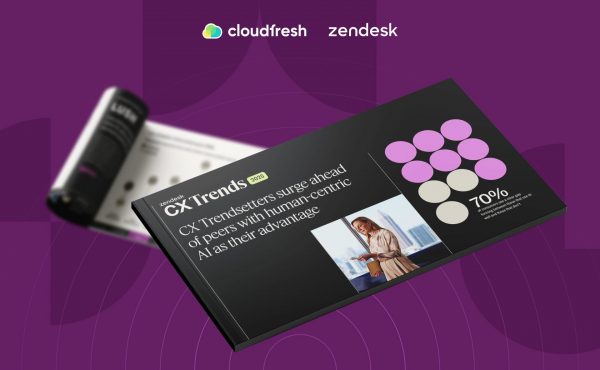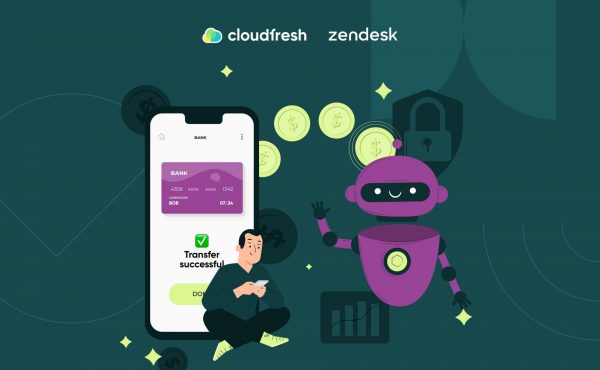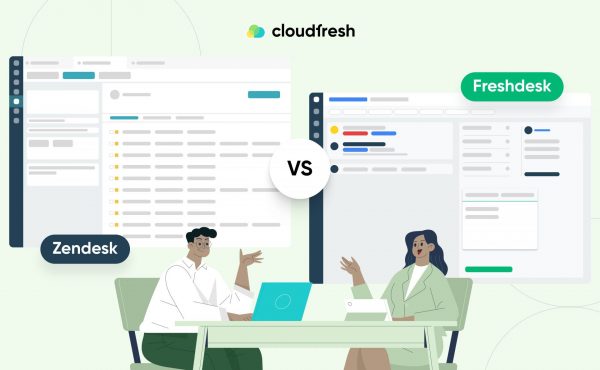CX Trends 2025 – Zendesk Revolution in Customer Experience
Zendesk AI Ticketing: Routing Both Requests & Agents
- Why Manual Ticketing Remains Problematic

- How Zendesk’s AI Ticketing System Solves Manual Ticketing Challenges

- Who We Are
Even when customer interactions are funneled through a unified platform, manual ticketing processes still miss the mark in delivering a smooth, efficient customer experience. Sure, centralization addresses some challenges, but it doesn’t wipe out the inefficiencies baked into manual handling.
In reality, relying on a unified platform paired with manual processes often creates a misleading sense of optimization. The Zendesk AI ticketing system is what businesses need to get rid of that false impression. But first things first.
Why Manual Ticketing Remains Problematic
Centralization Alone Can’t Fix Efficiency Issues
Sure, centralizing customer interactions on a unified platform gives you a single source of truth. But it doesn’t magically erase the inefficiencies tied to manual ticket handling. Agents still have to log, categorize, and update tickets by hand—a time-consuming process that often leads to delays and slower response and resolution times.
Picture this: A retail company uses a unified platform to manage customer complaints across e-mail, phone, and social media. An agent gets an e-mail about a defective product and manually logs the issue into the system. Later, the same customer calls the support line for a follow-up. The agent has to dig through the system to find the previous ticket and update it manually. It’s not just inefficient; it’s a recipe for customer frustration.
Human Slip-Ups Are Inevitable
Even with all data neatly collected and stored in one place, the risk of human error remains stubbornly high. As opposed to an AI ticketing system, manual processing makes mistakes like incorrect categorization, lost information, and incomplete details all too common.
Imagine a healthcare provider managing inquiries via a centralized platform. Say a patient needs a prescription refill, but the agent accidentally tags the ticket as a billing issue. Mistakes like these complicate things for customers and can also seriously damage a company’s reputation.
Automation’s Potential Is Overlooked
Missing out on features is one of the manual ticketing’s biggest drawbacks. Auto-routing, priority tagging, and follow-up reminders—all of those are off the table with no ticketing automation.
Take, for example, a SaaS company handling technical support requests. It might receive hundreds of tickets every day. But without automated routing in place, which is based on keywords or issue type, agents have to manually read and assign each ticket. That creates bottlenecks, stretches response times, and leaves customers less than thrilled. And without automatic prioritization, critical issues can easily get buried beneath less urgent ones.
Manual Systems Crumble under Pressure
Scalability is a major pain point when it comes to manual ticketing—even if you’re using a unified platform. As customer volume grows, trying to manage tickets manually becomes a losing battle. Sure, the platform might centralize data, but the manual handling of each ticket makes scaling a nightmare. Plus, the heavier workload leads to agent burnout and higher turnover rates.
Things get much easier once you embrace AI ticketing (more on that below). For now, picture an e-commerce platform during a Black Friday sale. Customer inquiries skyrocket, and the support team is, well, busy, to say the least. Agents are stuck manually creating, updating, and categorizing tickets at a pace that just can’t keep up. The outcome? Delayed responses, unresolved issues, and worst of all—lost sales.
The Reporting Gap
Just because data is centralized doesn’t mean it’s delivering valuable insights. When tickets are manually created and managed, reporting and analytics take a big hit thanks to incomplete or inconsistent data entry. Since reports rely so heavily on manual input, inaccuracies are almost guaranteed, making data-driven decision-making a real challenge.
Take a travel agency using a unified platform to manage bookings, cancellations, and general inquiries. If agents manually tag tickets with vague or inconsistent categories, generating meaningful reports becomes simply impossible. Without accurate analytics, the agency can’t spot trends, anticipate customer needs, or proactively rethink its services business models.
The Consistency Trap
A unified platform is supposed to make sure that customer queries across all channels are handled consistently. But manual ticketing introduces too much variability. The quality of ticket management heavily depends on agents correctly following prescribed processes—and that’s far from guaranteed.
Imagine a telco where agents tackle complaints from chat, e-mail, and phone. Even with a unified platform, the lack of standardized workflows means responses can vary wildly depending on the agent’s approach. Customers end up receiving different resolutions to similar issues, chipping away at their trust in the company’s support system.
Is It Really Omnichannel?
A unified platform might pull data from various channels, but unlike AI ticketing, the manual one makes delivering a smooth omnichannel experience a real struggle. When customers switch channels, they often have to repeat themselves because agents are stuck manually updating and syncing information across the platform.
Picture a banking institution using a unified platform to address queries from their mobile app, website, and call center. If a customer first engages in a conversation via live chat and then calls the support line for more help, the agent has to manually dig through previous chat logs. This doesn’t just waste the customer’s time—it leaves them with a frustrating experience.
The Missing Pieces to Peak Efficiency
The shortcomings of manual ticketing—even on a unified platform—make the need for automation and smart integration more evident than ever. If tasks like ticket categorization, routing, and prioritization are automated, tickets reach the right agents quickly, leading to slashed response times and higher efficiency across the board.
For instance, AI ticketing that is content- and context-aware could let support teams focus on solving problems instead of sorting them. Plus, integrating an automated ticketing system means high-priority tickets are flagged and addressed right away, leaving no room for critical issues to slip through the cracks.
How Zendesk’s AI Ticketing System Solves Manual Ticketing Challenges
Cutting Costs without Cutting Corners
Manual ticketing demands a lot of people to keep up with growing customer inquiries. During peak seasons like the holiday rush, businesses often scramble to hire temporary agents, driving operational costs through the roof.
Zendesk’s AI integration tackles this challenge head-on by automating high-volume, low-complexity interactions. Instead of expanding the support team, you can deploy AI chatbots to handle routine queries 24/7, no matter the volume. These chatbots deliver instant, accurate responses using conversational AI and provide high-quality service without needing late-night support teams.
Plus, AI helps cut down on expensive phone channels. While human agents can only assist one customer at a time over the phone, AI-powered digital support systems let agents handle multiple interactions simultaneously. The result? Reduced costs and maximized efficiency for your existing workforce.
AI That Actually Makes Agents More Productive
Zendesk’s AI ticketing system removes inefficiencies with automated ticket categorization, intelligent routing, and real-time recommendations. It quickly identifies what each ticket is about and directs it to the best-fit agent based on expertise, availability, and workload.
Agents benefit from AI-suggested responses and relevant knowledge base articles that pop up right within the ticket interface. With the need to hunt down information eliminated, Zendesk AI lets agents focus on delivering meaningful, personalized support. The payoff? Faster resolutions, boosted productivity, and higher customer satisfaction.
On top of that, AI-driven prompts and suggestions help agents navigate tricky situations while staying on brand and providing consistent service. In fact, Zendesk’s AI features have been shown to shave an average of 45 seconds off each ticket compared to manual triaging.
Scaling without the Growing Pains
Zendesk’s AI ticketing makes scaling easy and allows businesses to expand or contract their support capabilities without sacrificing quality. When ticket volumes spike, AI-powered bots step in to handle repetitive queries instantly, freeing up human agents to tackle more complex or high-value interactions.
Plus, the company’s artificial intelligence-driven knowledge management makes it possible for customers to self-serve at scale. Surfacing relevant help articles or troubleshooting guides right when customers need them, the Zendesk AI ticketing system reduces volumes and boosts the overall user experience.
And with generative AI taking care of content production (at least partially), you can expand and update your knowledge base to keep up with growing demand. Thanks to this kind of proactivity, your support teams are always ready to meet increasing volumes without missing a beat.
Turning Satisfaction into Loyalty
The Zendesk AI ticketing system is all about customers getting the help they need—fast. Through intelligent routing and triage, it matches incoming requests with the most suitable agents or departments, considering factors like customer needs, language, and sentiment to get things right from the start. This precise, immediate assignment slashes resolution times and boosts customer satisfaction.
AI chatbots also step in to handle routine inquiries instantly, delivering quick answers when customers need them most. In fact, the Zendesk Customer Experience Trends Report shows that 51% of consumers prefer interacting with bots for immediate assistance. Instant, accurate resolutions go a long way in improving the overall customer experience.
What’s more, Zendesk AI ticketing supplies agents with relevant suggestions and contextual insights, allowing them to provide more personalized interactions. From the business side of things, that translates to stronger loyalty, advocacy, and lasting relationships.
Make New Agents Feel Truly Welcome
Zendesk’s AI ticketing tools make agent onboarding faster and smoother by providing AI-generated suggestions, ticket summaries, and contextual insights right from the start.
With generative AI capabilities, new agents can turn brief notes into polished, clear responses that maintain the right tone. That way, you not only speed up training but also boost response quality from day one.
Resource Management That Just Works
Zendesk’s AI-powered workforce management (WFM) tools take the guesswork out of staffing. Enriched with historical data and predictive analytics, the system accurately forecasts ticket volumes and helps managers make smart, data-driven decisions about staffing levels and resource allocation.
Real-time insights into agent workload and activity make it easy to adjust schedules and responsibilities on the fly, so agents are always where they’re needed most. With automated forecasting and scheduling, businesses can deliver faster, more consistent service while keeping operational costs in check.
Quality, Assured
Maintaining high service standards can feel like an uphill battle with manual ticketing systems, where quality checks depend entirely on human effort. Quality assurance tools that come bundled with select Zendesk licenses change this by automatically highlighting conversations that need review—no more combing through thousands of tickets manually.
Once they’ve automated the QA process, businesses can monitor performance at scale and maintain consistent service quality, even as operations expand. Plus, AI-driven insights make it easy to spot areas for improvement, enabling targeted coaching and continuous agent development.
Who We Are
Why stick with the outdated when Zendesk makes time-consuming processes a thing of the past? The numbers speak for themselves:
- Tasks that used to take 4–5 hours now take only 5 minutes.
- Zendesk agents have helped manage nearly a million tickets per year for a single firm (definitely not the limit)—and across multiple channels at that.
- Automated triage has shown the ability to drive satisfaction rates to an impressive 92%.
- Chatbots addressing common inquiries have proven to land a remarkable 96% CSAT score.
As a Global Zendesk Premier Partner, Cloudfresh will guide your team toward AI-driven excellence across your entire support ecosystem with Zendesk Support Suite.
Our professional services include:
- Auditing at the Strategic Level.
- End-to-End Zendesk Implementation.
- Precision-Built Third-Party Integrations.
- Customized, Time-Efficient Onboarding & Training Tailored to Each Employee’s Needs.
- All-Out AI Consulting & Assistance.
Ready to make the shift? Fill out the form below to get started.















